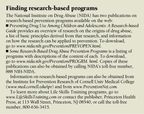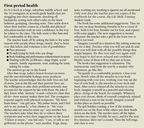Life skills training: A prevention program that works
From Reefer Madness to the latest "This is your brain on drugs" TV spots, scare tactics have failed to keep young people away from drugs. These authors think it's time to look at hard evidence and pick a prevention program with a proven track record.
Life skills training: A prevention program that works
By Steven P. Schinke, PhD, and Gilbert J. Botvin, PhD
From Reefer Madness to the latest "This is your brainon drugs" TV spots, scare tactics have failed to keep young peopleaway from drugs. These authors think it's time to look at hard evidenceand pick a prevention program with a proven track record.
Pediatricians are well known as advocates for prevention. They speakout for stringent clean air and water standards, lead paint abatement, immunizationdrives, and the Back to Sleep campaign because they've seen scientific evidencethat these measures can make a difference. That same requirement for scientificproof should also apply to prevention programs in behavioral areas likesubstance abuse.
Advances in the social and behavioral sciences make that demand a reasonableone. Adolesents' penchant for risky behavior is no longer an impenetrablemystery, and there is by now a body of scientific research on how attitudesand behavior can be changed. That research is beginning to pay off, yieldingsolid and empirically tested programs for preventing problems with tobacco,alcohol, and drugs among youth. Grounded in social learning theory,1these programs have been rigorously tested in real-life trials. Life skillstraining (LST), a program developed by the authors, is the research-basedapproach we will describe in detail here. For information on other programs,see box, "Finding research-based programs".

The Life Skills Training Program
This program is a classroom curriculum, embodied in a set of studentworkbooks and a manual of lesson plans for the teacher.2 It istaught over a three-year period, starting with 15 classroom sessions inthe first year (6th or 7th grade, usually), 10 booster sessions in the second,and five booster sessions in the third. It is used most frequently, althoughnot always, in health education classes.
The middle schooljunior high school age group was chosen becauseit's a transition point, a time when youngsters are poised between the antipathyto drugs that many children express in the lower grades, and the greateraccess to and acceptance of drugs that are more typical of high school students.Life skills training classes are intended to reach preteens and early adolescentsbefore they get to the stage where drug use seems normal, familiar, or acceptable.
Three major content areas are covered in the course:
- Drug resistance. Classroom activities increase students' awareness of social influences that promote drug use, correct the misperception that "everyone" uses drugs, promote antidrug behavior as the norm, and provide opportunities to practice resistance skills.
- Self-management. These lessons stress independence, personal control, and a sense of self-mastery. Students practice problem solving and decision making. They work through scripts ("You have a big test tomorrow and ought to stay home and study, but your friends are going to the movies and want you to come too. What do you do? How do you say No without alienating your friends?"), applying principles of clarifying the problem, considering alternative solutions, and choosing among them. They learn to recognize stress and anxiety and try out coping strategies, from deep breathing to yoga to working out. For a description of a class devoted to coping with stress, see box, "First period health".
- Social competence. Students practice--in situations scripted in the teacher's manual and scenarios they make up themselves--how to communicate the messages they intend, how to get over being shy, how to begin and end conversations. Social skills are taught througha combination of instruction, demonstration, feedback, reinforcement, rehearsal, and homework assignments.
Currently, about 300,000 students in grades six through nine are receivingthe LST program in their schools.

How do we know it works?
The LST program has been extensively tested and refined over the past18 years. Results indicate that the prevalence of alcohol, tobacco, andmarijuana use among students who have been through the program is from 50%to 75% lower than among controls who have not taken the classes.3 Long-termfollow-up data from a randomized field trial with nearly 6,000 studentsfrom 56 schools found significantly lower smoking, alcohol, and marijuanause six years after the initial baseline assessment. Twelfth graders whohad received a reasonably complete version of the intervention in seventhgrade showed the strongest effects, with up to 44% fewer drug users and66% fewer users of more than one drug than controls.4
Minority youth and out-of-school settings
Although early research with the LST program was conducted with white,largely middle-class populations, several recent studies show it is alsoeffective with inner-city minority youth. Different scheduling formats work,too, as do different levels of project staff involvement, and peer leadersinstead of adult teachers.5,6 Studies have validated adaptationsof life skills training among African-American, Hispanic, and Native Americanadolescents living in inner-city, suburban, and rural areas.7,8 Theseadaptations have been carefully designed to be culturally sensitive to thepopulation being served and in some instances have made the leap from workbooksand blackboards to technology that teens find more appealing, includinginteractive computer software and video disks. Life skills programs havealso been used successfully in a variety of community settings, includingPolice Athletic League youth groups and Boys and Girls Clubs located inpublic housing projects.9,10 For case examples showing how programparticipation can help teens and preteens learn to deal with challengingsituations, see box, "Children at risk".

What pediatricians do best
Screening patients at risk for substance abuse, counseling youth andparents, and making treatment referrals when indicated are integral aspectsof pediatric practice. But prevention is, as it always has been, the areain which pediatricians shine, in one-on-one relationships with patientsand families and in the wider community as well.
In the area of substance abuse prevention, there is a great deal of communityadvocacy to be done. For despite accumulating data supporting the effectivenessof research- based programs like LST, most schools still use programs thatare untested or ineffective. As respected and knowledgeable professionals,pediatricians can help communities bridge the gap between what researchshows to be effective and what schools are currently doing. One way to makeyour influence felt is to participate in community and school district taskforces on health, smoking, and drug abuse. These are excellent venues forfocusing the attention of community leaders on the need for research-basedprevention programs.
Another way to get involved is simply to ask local school officials whatthey are doing with respect to drug abuse or smoking prevention, and whetherthe approach they are using has been shown to be effective. If your schooldistrict has a community or parent advisory board that participates in choosingcurriculum, consider offering your services as member or adviser. You canalso ask community youth groupslike Scouts, Boys and Girls Clubs, and religiouslybased youth groups what programs they are using or considering, educatethem about research-based programs, and offer your services as a knowledgeableconsultant. Making war on drugs is a stirring slogan, but so far, sloganshaven't done the trick. Choosing tested methods is a more promising tactic,and one pediatricians can help their fellow citizens use successfully.
DR. SCHINKE is Professor of Social Work, Columbia University, New York,NY.
DR. BOTVIN is Professor of Public Health, Cornell University MedicalCollege, New York. Both authors are affiliated with the Prevention ResearchInstitute of Cornell University Medical College.
REFERENCES
1. Bandura A: Social Learning Theory. Englewood Cliffs, NJ, Prentice-Hall,1977
2. Botvin GJ: Life Skills Training: Promoting Health and Personal Development.Princeton, NJ, Princeton Health Press, 1996
3. Sloboda Z, David SL: Preventing Drug Use Among Children and Adolescents:A Research-Based Guide. Washington, DC, National Institute of Drug Addiction,1997; NIH Publication no. 97-4212
4. Botvin GJ, Baker E, Dusenbury L, et al: Long-term follow-up resultsof a randomized drug-abuse prevention trial in a white middle-class population.JAMA 1995: 273(14);1106
5. Botvin GJ, Schinke SP, Epstein JA, et al: Effectiveness of culturallyfocused and generic skills training approaches to alcohol and drug-abuseprevention
among minority adolescents: Two-year follow-up results. Psychol Addict Behav1995:9(3);183
6. Botvin GJ, Baker E, Filazzola AD, et al: A cognitive-behavioral approachto substance abuse prevention: One-year follow-up.Addict Behav 1990:15(l);47
7. Schinke SP, Moncher MS, Holden GW, et al: Preventing substance abuseamong Native American youth, in LeCroy CW (Ed): Case Studies in BehavioralSocial Work Practice. Homewood, IL: Dorsey Press, 1992
8. Schinke SP: American Indian behavioral health approaches to prevention,in Kato PM, Mann T (Eds): Health Psychology of Special Populations. Washington,DC, American Psychological Association, 1996, pp 367387
9. Schinke SP, Cole KC, Diaz T, et al: Developing and implementing interventionsin community settings. J Child Adolesc Substance Abuse 1997;6:49
10. Schinke SP, Orlandi MA, Cole KC: Boys and Girls Clubs in public housingdevelopments: Prevention services for youth at risk. J Commun Psychol 1992,OSAP Special Issue